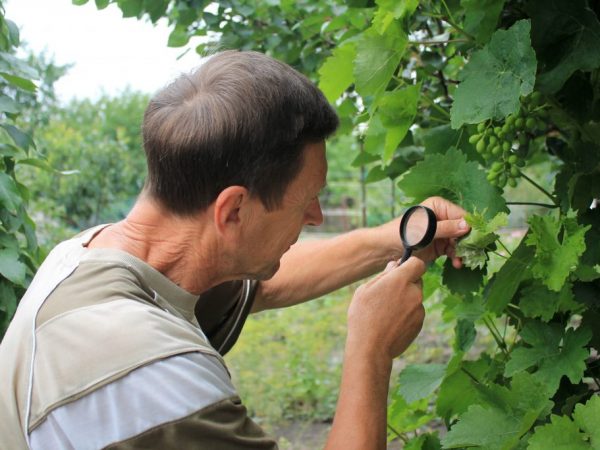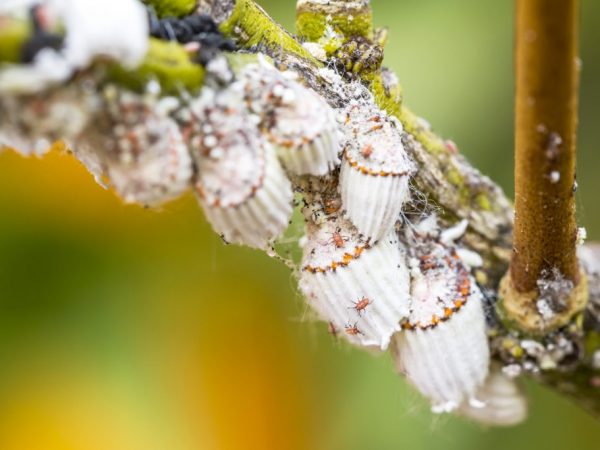Fighting scale insects on grapes
Vine shoots attract many pests that pose a threat to future crops. These include the scale insect on grapes. It feeds on plant juices, which leads to a decrease in yield, and sometimes to complete drying of the vine.

Fighting scale insects on grapes
How to recognize a scabbard
The scale is a small insect 0.5-5 mm in size, with a semicircular or oblong shell. She settles on woody plants. The color of the shield is varied: white, gray, orange, brown, black - it depends on the species.
Signs of presence
The initial signs of the appearance of a pest on grapes are rounded or oblong scales on the foliage with an oily bloom.
Often grapes are affected by a false shield, which settles on the underside of the grape foliage.
The places of appearance of insects depend on their varieties:
- Californian species and brown scale insects settle on the upper side of the leaf blade,
- palm prefers to live on the underside of the leaves,
- the olive variety can be seen on stems and leaf veins.
Scabbard harm
The main harm to grapes is caused by females and larvae feeding on grape juice, taking nutrients from the plant, weakening it and slowing down its growth. As a result, foliage and fruits wither in the vine.
Insects produce a sticky liquid - honeydew, on which a sooty fungus appears and actively develops, clogging the airways of the plant, which further worsens the state of the garden culture.
Chemical preparations in the fight against the scabbard
In the fight against the pest, insecticidal preparations are used. They are sprayed on the vine.
Admiral
An emulsion concentrate with the active substance pyriproxyfen has a narrowly targeted effect and is effective against the Californian scale insect. Leads to changes in the development of the pest. Applicable in spring and summer.
Aktara
It is an insecticidal preparation of systemic action with the active substance thiamethoxam. It has a wide range of applications, is effective when applied to soil, reaching the upper parts of the plant when irrigated in 3 days, and when spraying, it penetrates the foliage cells in a day.
It has an intestinal-contact effect on the Aktara scabbard, leading to their death within a day after the insect enters the body. The drug is used in warm weather. It is compatible with other insecticides.
Actellic

Insecticides will help get rid of pests
Actellic is a non-systemic drug with an insecticidal substance pirimifo-methyl. It has a wide range of uses. It has an intestinal contact effect on the pest, leading to death within 3 hours after use by spraying. The effectiveness of protection is maintained for up to 20 days.
Confidor Extra
It is an insecticidal granular systemic type preparation with the active substance imidacloprid.It has an enteric-contact effect on the pest, entering the insect's body through spraying. Protection efficiency - 30 days.
BI-58
Systemic insecticidal preparation for a wide range of applications with the active substance dithiophosphoric acid. It has a contact-intestinal effect. It is applied by spraying. Retains effectiveness for 20 days.
Folk methods of dealing with the scabbard
The use of folk remedies in the fight against scale insects on grapes has a lower efficiency compared to chemical preparations, but it is safer for horticultural crops.
Mechanical method
Harmful insects from grape foliage and stems are cleaned with a rag or toothbrush, previously soaked in soap, kerosene or alcohol solution. The disadvantage of the mechanical method of struggle is laboriousness and low efficiency, since the treatment has to be repeated several times.
Spraying
The affected vine is sprayed with soapy water (10 g of tar soap per 1 liter of water) or wood ash (300 g of ash powder is boiled in 1 liter of water for half an hour).
Decoctions from celandine and fern have effective properties:
- 3 kg of celandine is infused in 10 liters of water during the day, the affected plantings are sprayed with a strained solution,
- 1 kg of fern is infused in 10 liters of water for a day, after which it is boiled for half an hour, cooled and filtered, used for spraying.
Onions and hot peppers scare away harmful insects from grape plantings:
- 4 onions are chopped, infused in 1 liter of water for 4 hours, filtered and used for spraying,
- 100 g of chopped hot pepper is boiled in 1 liter of water for 15 minutes, then infused for 1 day, filtered and a working solution is made and 10 ml of concentrate per 1 liter of water is calculated.
Agrotechnics
Agrotechnical measures are supposed to be combated by reducing the number of watering, since the shield loves high humidity.
Prevention against scale insects
Among the preventive measures that can prevent the appearance of insects on grape plantations, the following are distinguished:
- after harvesting in autumn and at the onset of spring, the soil is dug up, fertilizing complexes are applied, dry branches and branches are cut off, root shoots are removed;
- before sheltering for the winter, the bark is cleaned of moss and lichen, subsequently treated with a solution based on tar soap.
Conclusion
The scale insect causes significant damage to the grapes, feeding on the sap of the plant, stopping its growth and leading to wilting. Chemical insecticides, alternative methods and preventive measures help from the scale insects on grapes.


